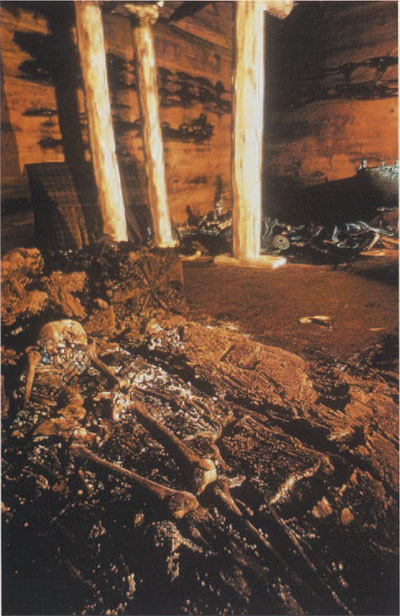
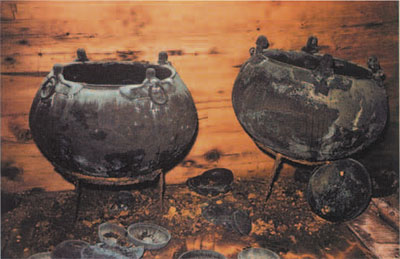
Fifty years ago, the University of Pennsylvania Museum of Archaeology and Anthropology began excavations at the ancient Phrygian capital of Gordion in central Turkey. Within six years, the expedition had made one of the most spectacular archaeological discoveries of the 20th century. In the largest burial mound at the site (see Miller’s Fig. I, this issue), they located what has since been identified as the tomb of Gordion’s most famous son, King Midas.
A drilling rig was used to bore deeply into the mound. Some 4.0 meters below the upper surface, the team, under the direction of Dr. Rodney S. Young, was rewarded with the discovery of a chamber, 5 by 6 meters in area. The excavators dug a horizontal trench into the side of the mound, then tunneled through a double wall of tree logs and timbers to reach the inner chamber, the earliest known intact wooden structure in the world.
Breaching the timber wall, the excavators were met with an amazing sight, not unlike that of Howard Carter’s first glimpse into Tutankamun’s tomb. At their feet was a body, laid out in state on a thick pile of dyed textiles inside a unique log coffin (Fig. I). An examination of the bones determined that the body was that of a male, aged 60-65. Taking other facts into consideration—the dating of the tomb (ca. 706 BC), its rich contents, a palace complex of the same period at the site, and Assyrian records describing an upstart ruler named Mita who controlled the people of Mushki (known as Phrygia by the Greeks) in eastern Anatolia—scholars are generally agreed that this is indeed the tomb of King Midas (see De-Vries, this issue).
The preservation of the tomb’s ancient organic materials, which generally degrade and rapidly disappear, was remarkable. Although the body of the king had disintegrated, patterns of purple and brown dyes were seen on the textile bedding when the tomb was first opened. Indigo blue was confirmed as one of the dyes by my laboratory in the Museum Applied Science Center for Archaeology (MASCA).
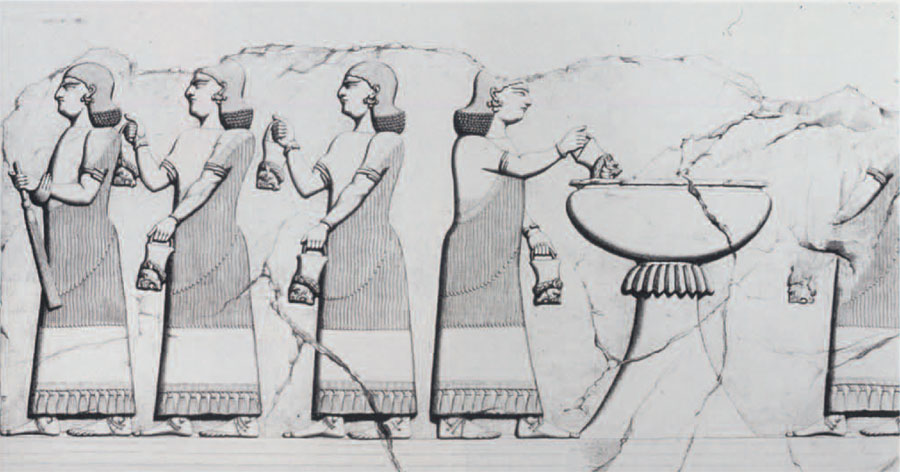
The Banquet Furnishings
The coffin, which had probably been used in a public viewing ceremony before being carried into the tomb (Simpson 1996), was accompanied by 14 wood furniture pieces, often intricately inlaid. These are best interpreted as serving and dining tables for a funerary banquet which was eaten by the mourners before the interment. The funerary banquet had been “re-created” inside the tomb by the ancient caretakers who laid out more than 156 metal vessels, the “most comprehensive Iron Age drinking set” ever found (Moorey 1986:195). Perhaps surprisingly, in view of Midas‘s legendary “golden touch” (Roller 1984), these vessels were made of bronze, not gold. Yet once accumulated layers of greenish oxidation were removed, the bronze gleamed like the precious metal. Three large vats (or cauldrons), with a capacity of about 156 liters each and mounted on iron tripod stands (Fig. 2), very likely held the beverage which was served at the feast (see Young 1981 for descriptions of all finds).
Banqueting protocol at a royal celebration of the time is graphically depicted on wall reliefs (Fig. 3) in the palace of the Assyrian king Sargon II at Khorsabad. A lion-headed spatula or bucket from the Midas Tomb (Fig. 4) is nearly an exact duplicate to the ones shown on the Sargon relief. This situia, another ram-headed situia, 2 jugs with long, sieved spouts, and 19 juglets would have enabled the beverage to be transferred to 5-liter round-bottomed buckets which were inset into unique serving tables (Simpson 1990 and 1996). From there, it was ladled into TOO finely wrought bronze omphaios drinking bowls (Fig. 5) and, for those with greater thirsts, 19 large two-handled bowls.
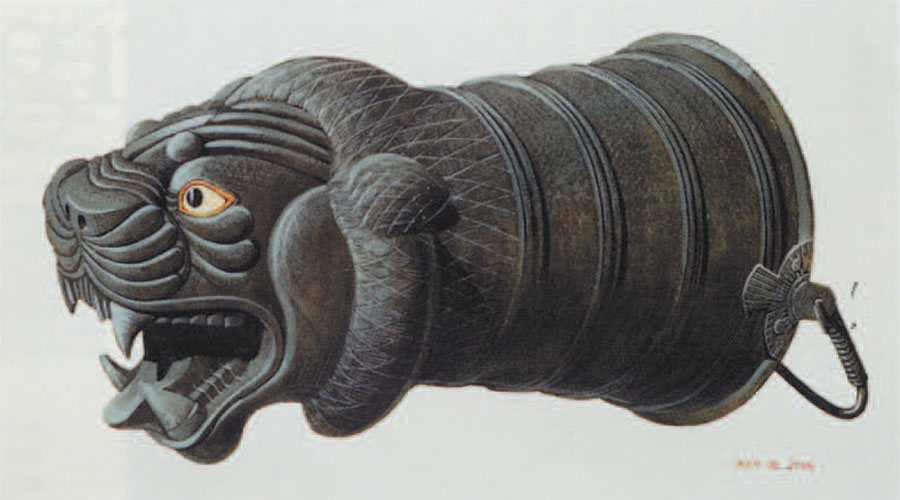
Remains of a Feast
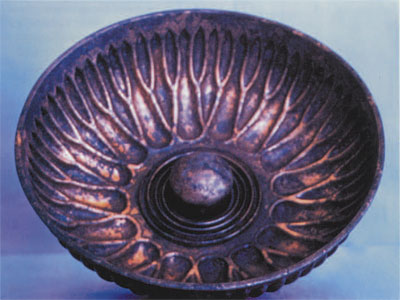
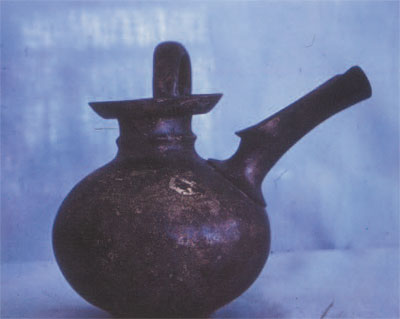
The riches in bronze were matched by a wealth of organic residues left in the drinking vessels. At Gordion, the importance of scientific methods in disentangling history from legend was already evident at this early stage, and the excavators shipped all the residues to Philadelphia in 1957 where they were examined by the Museum’s chemist, A. Eric Parkinson. The results were largely negative; highly sensitive analytical instruments simply weren’t available then to the extent they are now. Using destructive, wet chemical methods, Parkinson was able to show only that carbon, nitrogen, and other elements characteristic of organic materials were present.
The identification of specific organic compounds had to wait another 46 years until my laboratory took up where Parkinson had left off. We had already carried out dye analyses of the textiles from the tomb, and the prospect of learning more about the fermented beverages of the ancient Phrygians, as well as early Anatolian and Mediterranean cuisine, was enticing. No complicated custom clearances were needed, as Dr. Ellen L. Kohler, registrar and conservator for the expedition when the tomb had been excavated, had the foresight to collect the original samples, which were returned and retained in the Gordian archives in the intervening years.
Working closely with Dr. Donald L. Glusker and Lawrence J. Exner, my research team has been able to reconstruct the Midas Tomb funerary feast in minute detail using such methods as infrared spectroscopy, liquid and gas chromatography, and mass spectrometry. Because of the unusually large size of the samples and the microgram amounts that are now needed for analysis, most of the original samples remain for the future when even more advanced methods will be available.
The various chemical results complemented one another and gave an extremely consistent picture of what was drunk on that momentous occasion 2700 years ago (McGovern et al. 1999). Altogether. analyses were carried out on 16 residues from a range of bronze vessel types: the ram-headed and lion-headed “buckets” or situlae, a small vat used in serving, 9 small drinking bowls with omphalos or “belly-button” bases, and 4 large drinking bowls. The large vats or cauldrons, which would have contained the beverage at the start of the feast based on analogy, had not been sampled: possibly some residues still remain to be extracted from these vessels, now kept in the Museum of Ancient Anatolian Civilizations in Ankara.
The beverage in all the vessels was determined to be a mixture of grape wine, barley beer, and honey mead. Without going into all the chemical intricacies, our analyses focused on identifying “fingerprint” compounds for specific natural products. In the case of grape wine (McGovern et al. 1995 and 1997), tartaric acid or its potassium or calcium salts were detected in all the residues from the drinking-set vessels that were analyzed.
This acid occurs in large amounts in nature only in grapes. Expressed grape juice quickly ferments to alcohol because of natural yeast on some grape skins and especially because of the slow pressing methods used in antiquity and the high tempera tures of the Middle East. The acid will often convert to the salt and form a crystalline deposit inside a vessel.
Barley beer was marked by the presence of calcium oxalate, or “beerstone” (Michel et al. 1992). which settles out at the bottom and along the sides of beer fermentation and drinking vessels. A single vessel often served the same purpose in the ancient Near East, so it was difficult to eliminate this bitter-tasting substance from the brew. Although calcium oxalate is widespread in nature, high levels such as were detected in the Midas Tomb drinking vessels are unusual. Since these vessels most likely held a liquid, barley beer is the best candidate (sprouted barley or “malt,” an important ingredient of beer, has also been recovered from the palace area). The jugs with long, sieved spouts (Fig. 6) would have been especially well suited to filter out any spent grains or other debris from the brewing process (see Sams 1977).
Finally, the fermented beverage concoction was rounded off with honey mead. The long-chained, saturated carbon compounds of beeswax (Evershed et al. 1997), which can be preserved for centuries, provided the tell-tale evidence, together with gluconic acid. It is impossible to filter out all the beeswax when processing honey, so honey products always retain a small amount of the substance.

What was served at the Banquet?
If a mixed fermented beverage had been served at the funeral, was there also an entrée. or at least hoar d’oeuvres, to go with it? Eighteen pottery jars had been placed inside the large vats (Fig. 7). These jars—handleless dinoi and small “amphoras”—each contained as much as 15o grams (about a third of a pound) of a spongiform and brownish material, quite unlike the shiny, dark residues in a yellowish matrix found inside the bronze drinking vessels. The jars were also surrounded by large “clumps” of a similar-looking material, which at 86x magnification appeared to be a congealed homogenous biomass lacking cell walls.
The infrared results from one sample to the next—inclutng six dinopa, four amphoras, and four clumps—were like carbon copies of one another, and quite different from those of the beverage residues (Fig. 8). In collaboration with Drs. Robert A. Moreau and Alberto Nuñez at the Eastern Regional Research Center of the U.S. Dept. of Agriculture and Dr. Chad Quinn of SmithKline Beecham Pharmaceuticals, specific fatty acids and lipids characteristic of sheep or goat fat were identified by liquid chromatography—mass spectrometry. The presence of intact triglyceride, which are stored as a prime energy source in fat globules (atpocytes) of animal tissue, attested to the extraordinary preservation conditions inside the tomb.
These findings dovetailed well with those of Dr. Curt Beck of Vassar College and Eric Butrym of Scientific Instrument Services, who detected capric, caprylic, and capric acids using gas chromatography—mass spectrometry. These short-chained acids, whose common names are derived from the Latin root caper meaning “goat,” have a very distinctive, even rancid, odor.
In addition to sheep or goat meat, a variety of other ingredients were detected in these residues. Phenanthrene, a stable aromatic hydrocarbon, and cresol, a phenol derivative, implied that the meat was first barbecued before it was cut off the bone. Honey, wine, and olive oil, which might have been used to marinate or barbecue the meat or to add their own distinctive flavors, were respectively represented by gluconic, tartaric, and oleic/elaidic acids. Besides large amounts of cholesterol, which would be expected in a meat dish, a high-protein pulse—most likely, lentils—was present, as revealed by a related plant steroid, chondrillasterol, and the triglyceride 2-oleodistearin. Indeed, large stocks of lentils and cereals were found in storage jars in the kitchens of builtngs across the street from what is almost certainly Midas’s palace on the Gordion citadel (DeVries 1986).
The finishing touches to this stew were provided by herbs and spices: anisic acid (characteristic of anise or fennel) and a-terpineol and terpenoids found in various spices were identified. Whether or not the ancient Phrygians imported real pepper from the Indian subcontinent this early is unknown. Dr. Naomi F. Miller. MASCA’s paleoethnobotanist and a long-time member of the Gordion team (see her article, this issue), reports that pulses of some domesticated and wild legumes, inclutng bitter vetch (Vicpaa) and wild fenugreek (Trigonella) which grow around Gordion today, have a very bitter taste. They may have been used as flavoring agents.
Our chemical findings reveal that the main entree at the funerary feast of King Midas was most likely a spicy lentil and barbecued sheep or goat stew (Fig. 9). Roasted whole suckling lamb or kid was also a great favorite in antiquity, as were skewered meats (like modern Greek souvlaki). Their preparation is described in the Homeric epics (Iliad 9:262-17, and 23.29-56), which were composed in the same century that Midas ruled or somewhat earlier. Indeed, many other archaeological details of the Midas Tomb have close parallels in Homer: multi-layered textile bedding, a mound of earth built over a tomb, and funerary feasts for famous personages that included libations and meat sacrifices (Iliad 23.29-56: 24.645-646, 666-667, 861-863; compare 23.194-198 and 218-221: also see Simpson 1996).
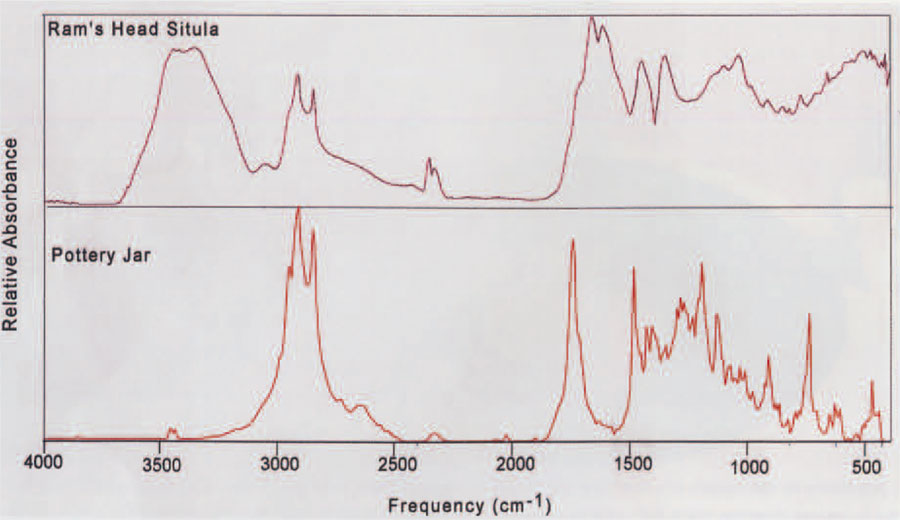
Although some components of the stew were prepared separately and might have entered in at tfferent stages of the ceremony, the uniform chemical composition of the contents of eight pottery vessels and four clumps that were analyzed strongly suggests that the ingredients were cooked together to make a stew; otherwise. one must imagine the leftovers being tvided up and distributed equally to each vessel. The absence of bones, olive pits, or other seeds and grains also fits best with a well-prepared stew. now attested in the cult center of 13th century BC Mycenaean, Greece. as well as other Bronze Age sites on Crete (Tzedakis and Martlew 1999).
A European Cuisine
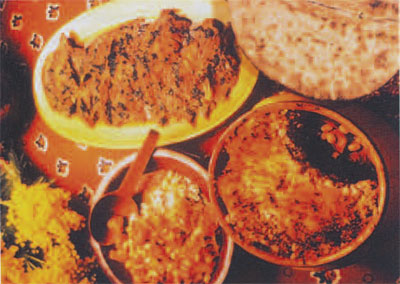
After A. Macmiadhachain et al,. The Mediterranean Cookbook (Seacauscus, NJ: Chartwell, 1979), p77. Photo by H. Fred Schoch
The extraordinary drinking set, which was used to serve the accompanying mixed fermented beverage of wine, beer, and mead, has an importance that extends well beyond Midas and his funerary feast. Later Greeks would have turned up their noses at such a concoction, but Homer also describes a drink (Gk. Kykeon) that combines wine, barley meal, honey, and goat’s cheese (Iliad 11:628-643; Odysseys 10.229-243). Recent chemical analyses by my laboratory of numerous Late Mycenaean and Minoan drinking vessels have also shown that they were filled with the same mixed fermented beverage as that in the Midas Tomb (McGovern 1999: Pain 1999).
How could two seemingly disparate cultures—Late Bronze Greece (ca. 1466-1260 BC) and Iron Age Phrygia—share the same taste in beverages? The answer may lie farther north in Europe, where a mixed fermented beverage (see Sherratt 1987) was being enjoyed at least 4000 years earlier than the time of the Vikings, with whom mead drinking is most closely associated. Grapes grew less well in cold northern climes, but honey was abundant there, and other fruits (especially apples and cranberries) were available to produce what we might today call a punch or toddy. Scholars have long argued that the Mycenaean Greeks were European invaders. The Phrygians are also believed to be of European extraction via the Balkans and northern Greece. Thus, the predilections of the two peoples for mixed fermented beverages might well be explained by their common European origins. As grape vines proliferated and winemaking improved varietal wines from particular regions became a mark of “civilized” life and “barbaric” beer and mead were pushed to the sidelines. Yet, mead remained a speciality of the Phrygians until at least the 1st century of our era (Pliny the Elder, Natural History, 4.113).
The drinking set proper is another fascinating part of the story, which can only be touched on here. It was to develop later into the standard wine set of classical Greece, which was the focal point of the symposion (literally, “drinking together”) and the Roman convivium. Specific vessel types for preparing and serving wine, in particular, had already made their appearance in royal banquet scenes and drinking ceremonies by around 3000 BC in the Near East (McGovern et al. 1997). Elite individuals in Greece had adopted the drinking set by at least 1700 BC, even though a somewhat different beverage was served and local customs differed.
As a result of a remarkable archaeological discovery and the advent of modern scientific tools. we have been able to put later accounts of King Midas, best summarized by the Roman writer Ovid (Metamorphoses 11.85-193), to the test. Of course, many of these tales have tong been understood to be highly fanciful. The decomposed body of “King Midas,” lying in state in his coffin, might be viewed as the just reward for his overindulgence. Yet, he lived to the ripe old age of 60 or 65, far exceeding the average life expectancy of the time (although those who survived into adulthood sometimes lived to be very old). Contrary to legend, he does not appear to have starved as a result of a putative “golden touch” or to have poisoned himself. If his funerary feast reflects what he ate and drank in life, Midas benefited from a high-protein diet and the enhanced antioxidant and nutritional content of a fermented beverage.
Acknowledgments
Dr. Elizabeth Simpson first proposed the project to the writer, and has been an invaluable resource of help and encouragement, from indexing and repackaging the ancient samples to providing references and stimulating discussions of the evidence. Other colleagues, many of whom are directly connected with the Gordian Project, were also very helpful in the preparation of this article. viz., Drs. Keith DeVries, Robert C. Henrickson, Ellen L. Kohler, Earle Leichty, Machteld J. Mellink, Naomi F. Miller, Rudolph H. Michel, and G. Kenneth Sams, the current trector of the Gordion Project. The research was made possible by the first Museum grant in “New Technology” from the J. M. Kaplan Fund. The recent chemical analyses of Mycenaean and Minoan pottery were done in collaboration with Drs. C. Holley Mardew and Yannis Tzedakis, with support from the European Union. All photographs are courtesy of the Gordion Project, except Figs. 3, 8, and 9.
